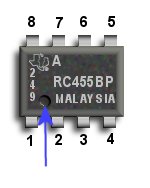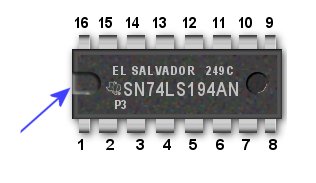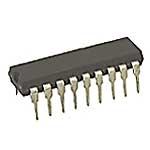Integrated circuits, or IC's for short, play an important part in most electronic circuits. As their name
implies they are a complete circuit on a silicon chip. You must be careful handling IC's, and be sure to
use all ESD rules. IC's come in many different sizes, and pin numbers. Some of the most common come in
8 pin, 14 pin, and 16 pin.
When using IC's, particlary memory chips, use of a socket is a good idea. A socket
is soldered on to the circuit board first, and you don't have to as careful as if you were soldering on the
IC. Then you simply plug the IC into the socket. Using a socket also makes removal of suspect IC much easier.
I suggest always using a socket when you can. Sockets come in many sizes to fit most of the different IC's.
Figure 1 below shows a typical socket.

Figure 1
IC's pins are numbered, and by these numbers you can determine which pin does what. Don't worry, as you don't
need to have any knowledge of how a paticular IC works to use them in circuits. Just make sure that the numbers
match, and that you have them orienated correctly. Figure 2 shows how to determine the pin numbers on IC's.
Two IC's are shown, an 8 pin and a 16 pin. The blue arrows are either pointing at a dot or a notch on the IC's
which always reference pin 1.
 
Figure 2
Again the rules for handling IC's are: 1. Follow all ESD rules 2. Always use sockets 3. If you can't use a
socket don't get them too hot while soldering, and 4. Be sure to orient the IC's correctly.
|





